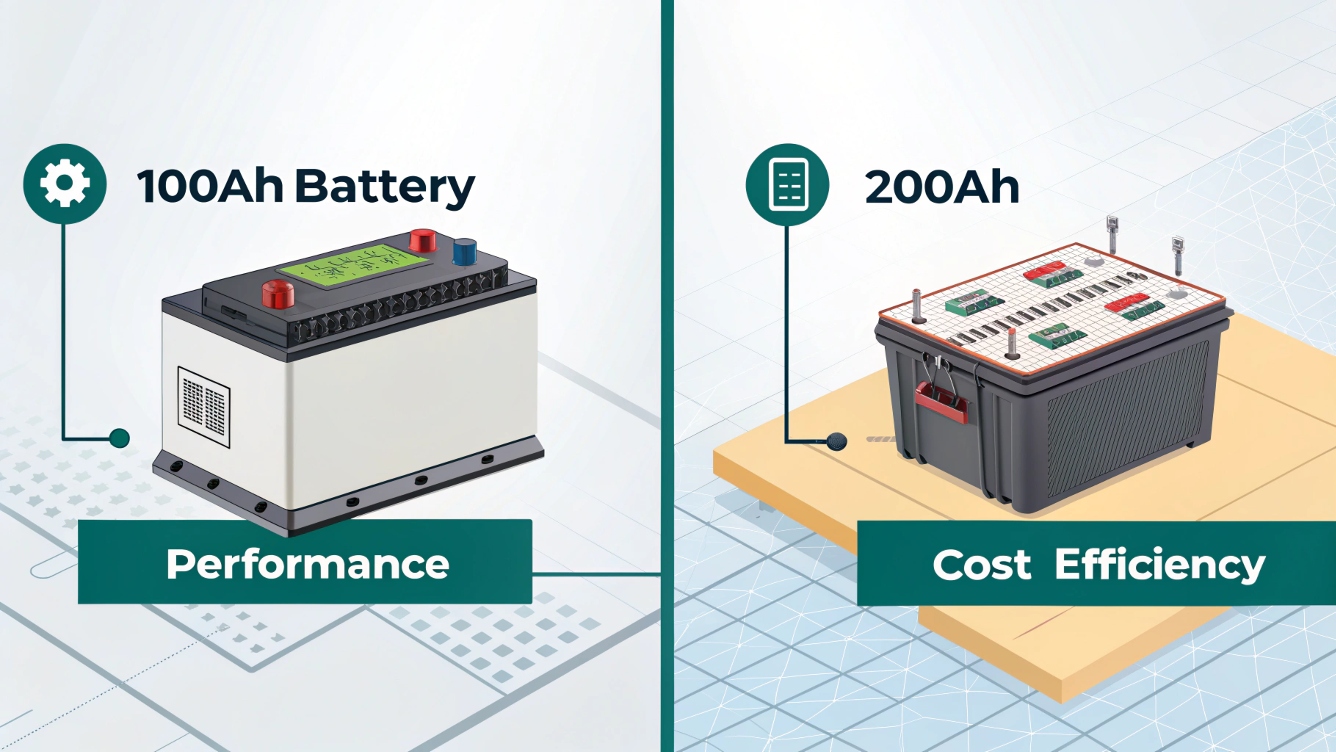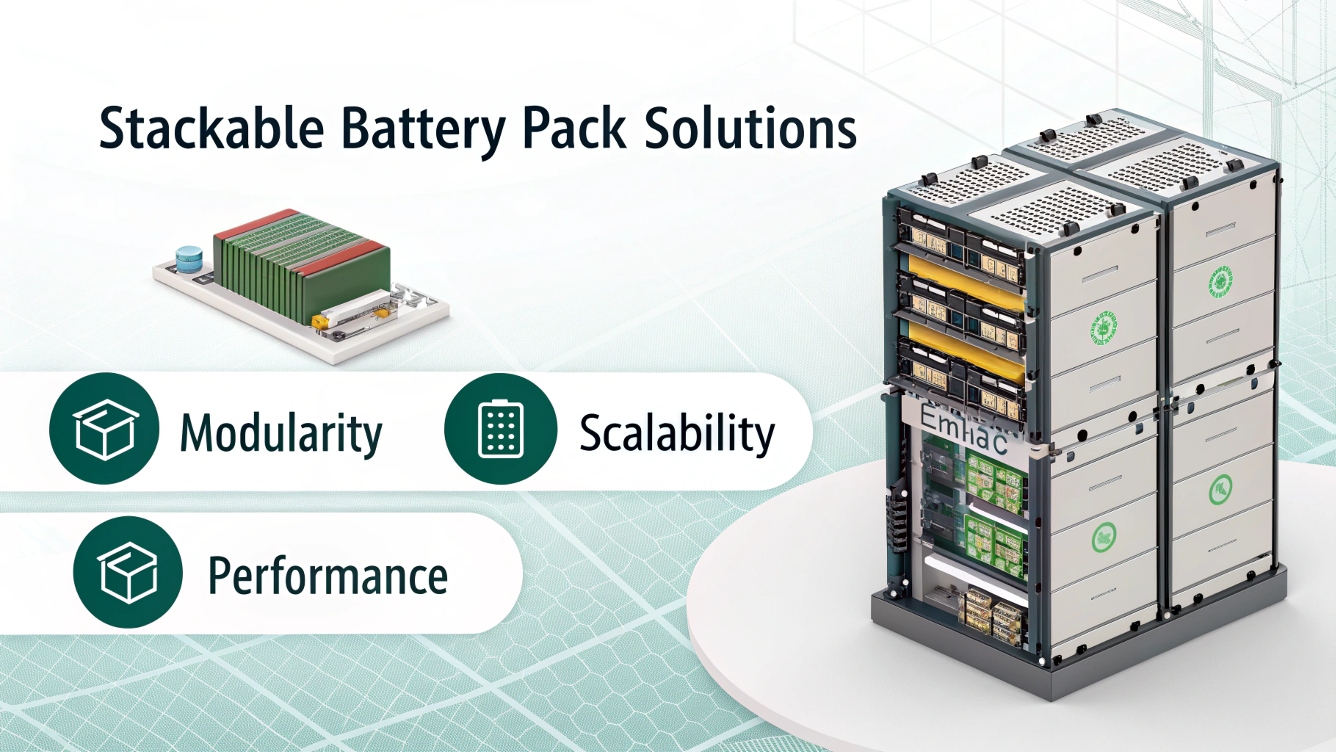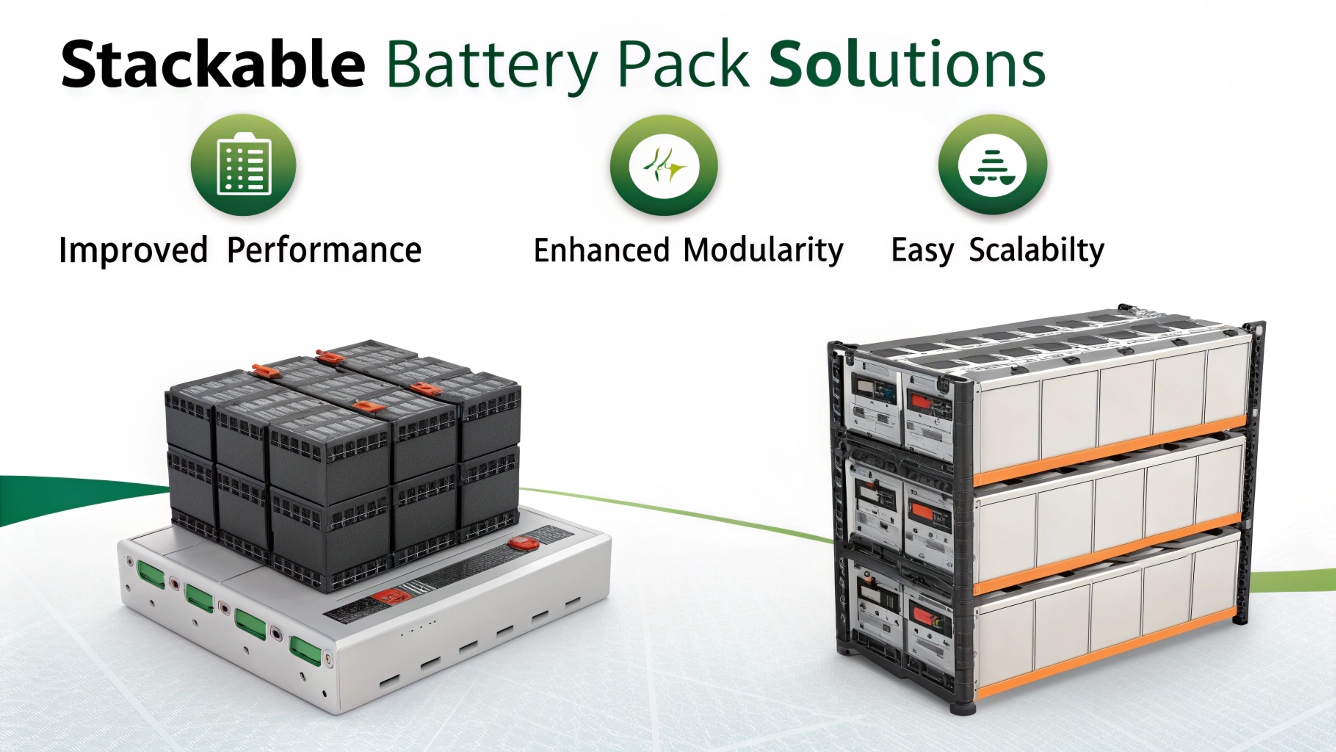더 낫습니다 2 100아 리튬 배터리 또는 1 200아 리튬 배터리? 쌓을 수있는 배터리 팩 솔루션에 대한 통찰력
올바른 배터리 구성을 선택하는 것은 에너지 저장 시스템을 설계하는 사람에게 중요한 결정입니다.. 100AH 리튬 배터리 2 개 또는 단일 200AH 장치를 선택해야합니까?? 이 기사에서는, 우리는이 질문을 탐구하면서 현대의 이점을 조사합니다. 쌓을 수 있는 배터리 팩 솔루션. 기술을 이해함으로써, 간결한, 이러한 구성의 실질적인 측면, 에너지 요구와 장기 지속 가능성 목표에 맞는보다 정보에 근거한 결정을 내릴 수 있습니다..
이 기사의 데이터 및 기술 정보는 Wikipedia 's에 요약 된 업계 표준 및 주요 수치에 의해 뒷받침됩니다. 리튬이온 배터리 페이지.
소개

재생 에너지 시스템이 더 널리 퍼져 있습니다, 신뢰할 수 있고 확장 가능한 배터리 스토리지가 증가합니다. ~에 GYCX 솔라, 우리의 고급 제품은 효율성을 제공하도록 설계되었습니다, 모듈성, 그리고 강력한 성능. 오프 그리드 태양열 설치에 전원을 공급하든 백업 전원 시스템을 통합하든, 배터리 구성의 뉘앙스를 이해하는 것이 필수적입니다.
100AH 리튬 배터리 2 개를 200AH 리튬 배터리 1 개와 비교할 때, 몇 가지 요소가 작용합니다: 성능, 확장 성, 비용, 유지 보수의 용이성, 장기 신뢰성. 특히, 현대의 쌓을 수 있는 배터리 팩 솔루션은 새로운 수준의 유연성을 도입했습니다, 사용 가능한 에너지를 최적으로 사용하는 동시에 사용자가 시스템을 점차적으로 확장 할 수 있도록합니다..
이 안내서는 각 구성의 주요 구성 요소를 분류합니다., 쌓을 수있는 시스템의 이점에 대해 논의합니다, 제품 범위의 예제를 사용하여 에너지 저장 시스템에 대한 최상의 성능을 달성하는 방법을 설명합니다..
배터리 구성의 주요 요인
2 × 100AH 대 토론에 뛰어 들기 전에. 1× 200Ah 배터리, 배터리 성능과 비용 효율성에 영향을 미치는 주요 요인을 이해하는 것이 중요합니다..
용량 및 에너지 밀도
정의 된 용량:
두 구성 모두 동일한 총 용량을 제공합니다 (200아), 그러나 에너지가 세포 전체에 분포되는 방법에는 차이가 있습니다.. 단일 200Ah 배터리에는 종종 더 큰 셀이 있습니다, 이는 내부 저항과 전반적인 에너지 밀도에 영향을 줄 수 있습니다.에너지 밀도 및 성능:
더 큰 세포는 때때로 더 높은 에너지 밀도를 가질 수 있습니다, 그러나 열적으로 관리하기가 더 어려울 수 있습니다. 더 작은 세포, 반면에, 일반적으로 개선 된 열 관리를 제공하며 쌓을 수 있는 배터리 팩 모듈 식 확장이 가능합니다.
중복성 및 신뢰성
- 여러 장치로 중복성:
2 개의 100AH 배터리를 사용하면 내장 된 중복성이 제공됩니다. 배터리가 발생하는 경우 문제가 발생합니다, 다른 하나는 여전히 부분적 지원을 제공 할 수 있습니다, 안전 층을 추가합니다. - 단일 장치 단점:
단일 200AH 배터리는 단일 고장 지점을 나타냅니다.. 해당 배터리가 결함을 경험하면, 전체 에너지 저장 시스템이 손상 될 수 있습니다.
유지 보수 및 업그레이드 가능성
- 서비스 가능성:
두 개의 별도 배터리로, 유지 보수는 더 유연 할 수 있습니다. 전체 시스템을 종료하지 않고 하나의 배터리를 교체하거나 서비스 할 수 있습니다.. - 스태킹을 통한 모듈성:
현대의 쌓을 수 있는 배터리 팩 시스템은 더 작은 용량으로 시작하고 필요에 따라 더 많은 모듈을 추가 할 수 있습니다.. 이 모듈 식 접근법은 시간이 지남에 따라 시스템 용량을 확장하는 데 이상적입니다., 사용하지 않는 용량에 대한 과잉 지불을 보장합니다.
비용 고려 사항
초기 비용 대. 수명주기 비용:
선행 투자는 두 구성마다 다를 수 있습니다. 추가 관리 시스템 및 상호 연결 하드웨어가 필요하기 때문에 두 개의 작은 배터리가 처음에는 더 비쌀 수 있습니다., 그러나 교체 성이 쉽고 완전한 시스템 다운 타임의 위험이 낮아 장기적으로 더 경제적 일 수 있습니다..쌓을 수있는 시스템의 규모의 경제:
ㅏ 쌓을 수 있는 배터리 팩 에너지 요구가 증가함에 따라 작게 시작하고 추가 용량에 점차 투자함으로써 비용 이점을 제공 할 수 있습니다.. 이 확장 성은 각 단계에서 필요한 비용 만 지불하도록합니다..
기술 비교: 2× 100AH 대. 1× 200AH
두 가지 구성을 비교하기 위해 기술적 측면을보다 자세하게 세분화합시다..
전기 성능 및 내부 저항
시리즈 및 병렬 구성:
배터리가 연결된 경우, 전기 특성은 크게 변할 수 있습니다. 동시에 두 개의 배터리가 부하를 공유합니다, 효과적인 내부 저항을 낮추고 더 부드러운 전력 전달로 이어질 수 있습니다.. 이것은 현재 피크가 높을 수있는 시스템에서 특히 유익합니다..열 관리:
작은 배터리는 단일 큰 배터리보다 더 효과적으로 열을 분산시키는 경향이 있습니다.. 효율적인 열 소산은 분해를 예방하고 장기 배터리 건강 보장에 중요합니다..효율성에 미치는 영향:
내부 저항이 낮아지면 충전 및 배출 중에 열로 에너지 손실이 줄어 듭니다.. 이 효율 이득은 a에서 향상 될 수 있습니다 쌓을 수 있는 배터리 팩 각 모듈이 최소한의 손실을 위해 최적화되는 설계.
안전 및 실패 모드
개별 배터리 보호:
다중 단위 구성에서, 각 배터리는 일반적으로 자체 배터리 관리 시스템과 함께 제공됩니다. (비엠에스), 전압과 같은 중요한 매개 변수를 모니터링합니다, 현재의, 그리고 온도. 이것은 하나의 배터리의 결함을 분리 할 수 있음을 의미합니다., 총 시스템 고장의 위험을 줄입니다.대형 배터리의 통합 된 BM:
단일 200AH 장치는 더 복잡한 BMS를 가질 수 있습니다.. 최신 BMS 시스템은 매우 신뢰할 수 있습니다, 복잡성은 BMS 오작동이 발생하면 시스템 전체 고장의 위험을 증가시킵니다..
실제 사용 시나리오
주거용 태양 광 시스템:
주택 소유자는 종종 중복성과 유지 보수 용이성을 중요하게 생각합니다. 100AH 배터리 2 개는 유지 보수 중에도 시스템의 일부를 유지할 수 있습니다.. 게다가, 이것을 a에 통합합니다 쌓을 수 있는 배터리 팩 에너지 소비 패턴이 시간이 지남에 따라 변화함에 따라 시스템은 추가 유연성을 제공 할 수 있습니다..상업 및 산업 응용:
더 큰 설치에서, 확장 성과 비용 효율성이 중요합니다. ㅏ 쌓을 수 있는 배터리 팩 시스템은 상업용 사용자가 기준 용량으로 시작하고 에너지 요구가 증가하거나 예산이 허락함에 따라 더 많은 모듈을 추가 할 수 있도록합니다.. 이 방법은 또한 업그레이드 또는 교체 중 다운 타임을 최소화합니다.
스택 가능한 배터리 팩 솔루션의 이점

a의 개념 쌓을 수 있는 배터리 팩 모듈성의 장점을 함께 제공합니다, 확장 성, 성능 향상. 다음은 몇 가지 주요 이점입니다:
모듈성 및 확장 성
증분 확장:
쌓을 수있는 디자인으로, 더 작은 것으로 시작할 수 있습니다, 관리 가능한 시스템 및 점차적으로 더 많은 용량을 추가합니다. 이것은 시간이 지남에 따라 에너지 요구가 증가 할 것으로 예상되는 상황에서 특히 유용합니다..재구성의 용이성:
모듈 식 접근 방식을 사용하면 배터리 뱅크를 재구성하여로드 요구 사항을 더 잘 일치시킬 수 있습니다.. 예를 들어, 에너지 소비가 증가하는 경우, 전체 시스템을 교체하지 않고도 다른 모듈을 추가 할 수 있습니다..
향상된 신뢰성
내장 된 중복성:
쌓을 수있는 배터리 팩은 본질적으로 중복성을 제공합니다. 하나의 모듈이 실패하거나 유지 보수가 필요한 경우, 나머지 모듈은 계속 전력을 공급할 수 있습니다, 최소한의 혼란을 보장합니다.분산 된 BMS 모니터링:
쌓을 수있는 시스템의 각 모듈에는 일반적으로 자체 BM이 포함됩니다., 보다 세분화 된 모니터링 및 제어를 제공합니다. 이로 인해 전체 시스템 안정성이 향상되고 배터리 수명이 길어집니다..
비용 효율적인 투자
초기 투자가 낮습니다:
대형 배터리 시스템에 선불에 투자하는 대신, 현재 요구에 맞게 일치하고 필요에 따라 확장 할 수 있습니다.. 이 단계별 투자 전략은 예산 제약과 진화하는 에너지 수요와 더 잘 일치합니다..상각 업그레이드:
에너지 시스템의 수명에 따라, 자본 비용을 확산시킬 수 있습니다. 게다가, 더 높은 효율성과 유지 보수 비용 감소는 장기적으로보다 비용 효율적인 운영에 기여합니다..
유지 보수의 용이성
단순화 된 교체:
모듈 오작동해야합니다, 다른 시스템과 독립적으로 교체 할 수 있습니다., 가동 중지 시간을 최소화하고 전반적인 유지 보수 복잡성을 줄입니다.유연한 서비스 옵션:
여러 모듈로, 일상적인 유지 보수가 비틀 거리게 될 수 있습니다, 전반적인 에너지 저장 시스템이 지속적으로 작동하는지 확인합니다..

GYCX Solar의 제품 솔루션 통합
~에 GYCX 솔라, 모듈 식 및 쌓을 수있는 설계의 이점을 보여주는 고급 배터리 제품을 제공합니다.. 효율적인 에너지 저장 및 관리를 지원하는 주요 제품을 살펴 보겠습니다..
쌓을 수있는 리튬 배터리
우리의 쌓을 수있는 리튬 배터리 모듈 식 시스템에 완벽하게 맞도록 설계되었습니다. 증분 확장을 가능하게하고 강력한 성능을 제공합니다, 주거 및 상업용 응용 프로그램에 이상적입니다.
48v 랙 마운트 리튬 배터리
작고 효율적인 솔루션이 필요한 설치, 우리의 48v 랙 마운트 리튬 배터리 공간 절약 디자인에서 고용량을 제공합니다. 엔지니어링 된 효율은 a의 모듈 식 특성을 보완합니다 쌓을 수 있는 배터리 팩, 고밀도 설치에서 인기있는 선택입니다.
쌓을 수있는 배터리 저장
우리의 포괄적 쌓을 수있는 배터리 저장 확장 가능하고 안전한 에너지 저장 솔루션을 제공하기 위해 고급 기술과 실용적인 설계를 제공합니다.. 이 제품은 중복성이있는 시스템에 원활하게 통합되도록 설계되었습니다., 안전, 그리고 업그레이드의 용이성이 가장 중요합니다.
이 제품을 전략적으로 우리의 기사 내에서 연결함으로써, 우리는 사용자 탐색을 향상시킬뿐만 아니라 사이트의 SEO를 강화하는 강력한 네트워크를 만듭니다., 고객이 자세한 제품 정보에 쉽게 액세스하고 정보에 입각 한 구매 결정을 내릴 수 있도록.
실질적인 고려 사항 및 사용 사례

두 구성의 장단점과 쌓을 수있는 디자인의 장점을 자세히 설명하려면 다음과 같은 실제 시나리오를 고려하십시오.:
주거 오프 그리드 태양 광 시스템
전기 자동차 추가 및 기기 사용 증가로 인해 에너지 수요가 증가하는 집을 상상해보십시오.. 쌓을 수있는 배터리 팩에 100AH 배터리 2 개로 시작:
- 중복성:
하나의 배터리에 유지 보수가 필요한 경우, 다른 하나는 임계 부하에 계속 전원을 공급할 수 있습니다. - 확장성:
에너지가 증가함에 따라, 기존 배터리 스택에 추가 모듈을 원활하게 추가 할 수 있습니다.. - 비용 효율성:
초기 투자는 중등도로 남아 있습니다, 미래의 요구에 따라 용량을 확장 할 수있는 유연성으로.
상용 백업 전원 솔루션
중소 기업의 경우 중단 중에 백업 전원에 의존합니다:
- 신뢰할 수 있음:
쌓을 수있는 배터리 팩으로 제작 된 시스템은 하나의 모듈이 실패하더라도, 전체 시스템은 여전히 작동합니다. - 효율적인 공간 사용:
콤팩트 48v 랙 마운트 리튬 배터리 유닛은 제한된 공간에서 대용량을 제공합니다, 도시 또는 공간 제한 설정에 이상적입니다. - 다운 타임이 낮습니다:
전체 시스템을 종료하지 않고 개별 모듈에서 유지 보수를 수행 할 수 있습니다., 중요한 기간 동안 지속적인 작동을 보장합니다.
산업 규모 저장
산업 환경의 대규모 에너지 저장 시스템은 쌓을 수있는 디자인의 모듈성에서 엄청나게 혜택을받습니다.:
- 유연한 디자인:
회사는 기본 시스템으로 시작하여 에너지 저장 요구가 증가함에 따라 모듈을 추가 할 수 있습니다., 전체 배터리 뱅크를 교체하지 않고. - 최적화 된 효율성:
여러 모듈에 걸쳐 분산 된 BMS 컨트롤은 각 장치가 피크 효율로 작동하도록합니다., 전반적인 에너지 손실 및 운영 비용 절감.
데이터 분석 및 성능 메트릭
몇 가지 주요 데이터 포인트는 각 배터리 구성의 영향을 명확히하는 데 도움이 될 수 있습니다.:
| 매개 변수 | 2× 100AH 구성 | 1× 200AH 구성 |
|---|---|---|
| 총 용량 | 200아 (두 단위에 배포됩니다) | 200아 (단일 더 큰 장치) |
| 중복성 | 높음 - 실패의 경우 하나의 장치를 덮을 수 있습니다. | 낮은 - 단일 실패 지점 |
| 열 관리 | 일반적으로 더 작은 셀 디자인으로 인해 더 좋습니다 | 적절하게 관리하지 않으면 어려울 수 있습니다 |
| 유지 보수의 용이성 | 모듈은 개별적으로 서비스 할 수 있습니다 | 전체 장치는 서비스해야합니다 |
| 쌓을 수있는 시스템의 확장 성 | 우수 - 모듈 식 설정과 잘 통합됩니다 | 제한 - 확장에는 교체가 필요할 수 있습니다 |
이러한 메트릭은 표시되며 특정 시스템 설계 및 운영 환경에 따라 다릅니다.. 추가 기술적 인 세부 사항, Wikipedia 's를 참조하십시오 리튬이온 배터리 페이지.
결론
2 × 100AH 리튬 배터리와 단일 200AH 리튬 배터리를 결정할 때, 선택은 중복성을 포함한 여러 요인에 달려 있습니다, 열 성능, 유지 보수의 용이성, 그리고 미래의 확장 성. 현대의 쌓을 수 있는 배터리 팩 솔루션은 모듈성과 유연성의 강점을 강력한 강점과 결합하여 매력적인 이점을 제공합니다., 효율적인 에너지 관리.
~에 GYCX 솔라, 우리의 제품 라인 - 포함 쌓을 수있는 리튬 배터리, 48v 랙 마운트 리튬 배터리, 그리고 쌓을 수있는 배터리 저장- 이러한 요구를 충족 시키도록 설계되었습니다. 그들은 강화 된 신뢰성을 제공합니다, 간소화 된 유지 보수, 그리고 증가하는 에너지 요구에 적응하는 데 필요한 확장 성, 주거용 및 상업용 응용 프로그램 모두에 탁월한 선택으로.
각 구성의 장단점을주의 깊게 평가하여, 현재 요구 사항을 충족 할뿐만 아니라 미래의 성장에도 적응하는 스토리지 시스템을 설계 할 수 있습니다.. 여러 개의 작은 장치 또는 단일 큰 배터리를 선택하든, 쌓을 수있는 설계 접근 방식을 통합하면 시스템이 탄력적으로 유지됩니다., 비용 효율적입니다.


